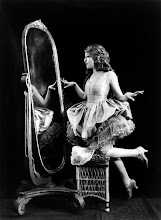 Perhaps the first horror film ever made, The Cabinet Of Dr. Caligari or as it was originally titled in German Das Gabinet des Dr. Caligari, came to the screen in 1920 as a German Expressionist film directed by Robert Weine. Thanks again to public domain, you can watch a wonderful version of the film here.
Perhaps the first horror film ever made, The Cabinet Of Dr. Caligari or as it was originally titled in German Das Gabinet des Dr. Caligari, came to the screen in 1920 as a German Expressionist film directed by Robert Weine. Thanks again to public domain, you can watch a wonderful version of the film here. The plot is somewhat elusive since the film is Expressionist, and all. The main character Francis (Friedrich Feher) tells a story about his friend Alan (Hans Heinrich von Twardowki) and Francis’s fiancée Jane (Lil Dagover). Alan and Francis go to a fair where they meet the strange Dr. Caligari (Werner Krauss) who shows his future-predicting sleepwalker Cesare (Conrad Veidt) to them. Cesare tells Alan he has until dawn to live and it comes to pass that Alan is murdered the next day. Cesare is the prime suspect and abducts Jane. Turns out, Dr. Caligari has been using Cesare to help him commit
The plot is somewhat elusive since the film is Expressionist, and all. The main character Francis (Friedrich Feher) tells a story about his friend Alan (Hans Heinrich von Twardowki) and Francis’s fiancée Jane (Lil Dagover). Alan and Francis go to a fair where they meet the strange Dr. Caligari (Werner Krauss) who shows his future-predicting sleepwalker Cesare (Conrad Veidt) to them. Cesare tells Alan he has until dawn to live and it comes to pass that Alan is murdered the next day. Cesare is the prime suspect and abducts Jane. Turns out, Dr. Caligari has been using Cesare to help him commit murders while sleepwalking for a period of time. Cesare runs away from those pursuing him, dying of exhaustion. After Cesare has died, they find Dr. Caligari has fled. Francis finds Caligari at a mental asylum. The ending at the asylum provides you with several twists and turns, making you wonder if anything in the film actually happened at all. The film may make you think or may leave you scracthing your head, trying to figure out what it was you just watched. Either outcome, I still think you should watch it.
murders while sleepwalking for a period of time. Cesare runs away from those pursuing him, dying of exhaustion. After Cesare has died, they find Dr. Caligari has fled. Francis finds Caligari at a mental asylum. The ending at the asylum provides you with several twists and turns, making you wonder if anything in the film actually happened at all. The film may make you think or may leave you scracthing your head, trying to figure out what it was you just watched. Either outcome, I still think you should watch it. The technical and artistic effects used in this movie are strange and wonderful, hence their appeal to the art and film lovers out there. The current time is done in strange blueberry hues whereas the flashback is done in dingy brown ones. This is one of the first films to do a “frame story” or flashback premise. The makeup is artistic and creates an image that is sort of a cross between a mime, a goth, Edward Scissorhands, and the guys from KISS. The scenery is extremely artistic and surreal. Most of the sets were made from paper and shadows were painted on the walls. The effects of the film are often citing as influencing film noir. The entire film has a dreamlike, surreal quality to it, which meshes perfectly with the macabre and unforeseen ending twists.
The technical and artistic effects used in this movie are strange and wonderful, hence their appeal to the art and film lovers out there. The current time is done in strange blueberry hues whereas the flashback is done in dingy brown ones. This is one of the first films to do a “frame story” or flashback premise. The makeup is artistic and creates an image that is sort of a cross between a mime, a goth, Edward Scissorhands, and the guys from KISS. The scenery is extremely artistic and surreal. Most of the sets were made from paper and shadows were painted on the walls. The effects of the film are often citing as influencing film noir. The entire film has a dreamlike, surreal quality to it, which meshes perfectly with the macabre and unforeseen ending twists.
An artical done on the plot and further exploration of the film can be found here, written by the film and movie buffs at Plume-Noir.com. The Plume-Noir article details how this film influenced future German Expressionist film as well as its impact on German films in the 1930s and those made when Hitler came to power. Also, the Moving Picture Blog has done a great study on the film as well, which you can read here. Joe Leydon of this blog probably did a better job of describing the film than I did, so I would highly recommend you checking this out if you want to know more about the film.






No comments:
Post a Comment